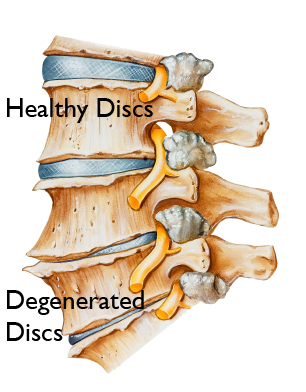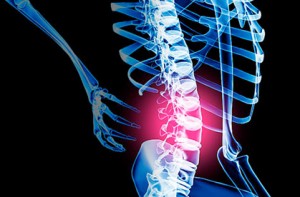Physio Health Advice > Degenerative Disc Disease
What are they?
Between adjacent vertebrae sit flexible discs that provide movement and shock absorption in the spine. In the thoracic region these are completely fibrous while the discs in the lower back and neck are filled with a jelly like substance and surrounded by protective, fibrous rings. The discs of the lower back are the largest as they need to transmit higher loads through the spine.
As we age, these discs lose hydration, height and elasticity. Unfortunately, this also means that the discs are unable to provide the flexibility and support they previously did. Like any form of soft tissue, discs can also become sprained and are able to heal. It is also possible for these discs to bulge and even have the jelly contents spill out into the surrounding region.
You may have heard people talk about having a slipped disc, however this is a misleading expression as discs almost never slip out of place and are very securely attached to the bones above and below them
What happens as the discs degenerate?
When these discs first begin to degenerate, abnormal stress is placed on the surrounding joints and muscles of the spine. Facet joints and the vertebrae themselves can also degenerate and produce small bony outgrowths called osteophytes, although these can occur independently of disc degeneration. During this period people may notice feeling stiff and sore at regular intervals. Symptoms are usually located in the neck and lower back.
As the degeneration progresses and the discs become less functional, episodes of pain will often be more frequent and more severe. Many people describe pain with prolonged sitting or standing, along with pain radiating into the hip or buttock region. Pain will often be relieved by changing positions, lying down or walking. Pins and needles or numbness may occur when the spinal nerves around the affected disc become irritated.
As disc degeneration continues, the spine actually becomes more stable with painful epidodes subsiding in severity and frequency.
Disc degeneration is considered to be a normal part of aging, however research on twins has shown that a genetic predisposition to degeneration is the most accurate predictive factor. Smoking, poor nutrition, posture and biomechanics may also increase your chances of suffering from disc degeneration.
How is it diagnosed?
Your physiotherapist can diagnose this condition clinically with a thorough examination, including careful questioning and in depth assessment. In most cases imaging is not required, however if you have had previous medical imaging please bring this to your initial appointment.
An important thing to note in spinal pain is that many people can have severe back pain without an obvious finding on their imaging and other people have no pain with very significant structural changes in their back. Some people have even had their discs rupture and heal without realising it!
How can physiotherapy help?
Treatment of any spinal disorder is often complex and your physio will tailor your management plan to suit you. Many people respond well to specific strengthening exercises, particularly Pilates style exercise. Trigger point therapy or dry needling can help to relax muscles that are often abnormally tight, reducing pain. Your physio is also trained to safely mobilise the spine, which allows the back to move with improved range and can reduce pain.
Your physiotherapist will have a great deal of advice and education for you to assist in managing your symptoms. Diagnosis of a condition such as degenerative disc disease can be daunting, however it doesn’t have to be a life sentence of pain.
For more information, speak to your physiotherapist about treatment options.
Click here to book an appointment.



